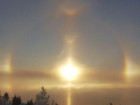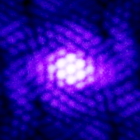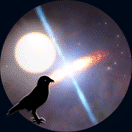|
Defining Planethood
|
|
| midtskogen | Date: Thursday, 16.06.2016, 11:23 | Message # 181 |
 Star Engineer
Group: Users
 Norway
Norway
Messages: 1674
Status: Offline
| Quote Watsisname (  ) One other thing is it completely avoids the issue of binary planets vs. moons, Trojan bodies, and the like. How would you classify two objects of similar size/mass orbiting each other, orbiting the sun?
Perhaps:
1) Orbits one or more stars or stellar remnants
2) Is in hydrostatic equilibrium
3) Doesn't undergo fusion currently or in the past
4) Doesn't share a centre of gravity within another object satisfying the above
That should exclude moons and allow double planets. Trojan planets would also be allowed, which to me makes sense.
NIL DIFFICILE VOLENTI

Edited by midtskogen - Thursday, 16.06.2016, 13:17 |
| |
| |
| steeljaw354 | Date: Thursday, 16.06.2016, 19:27 | Message # 182 |
 World Builder
Group: Users
 Pirate
Pirate
Messages: 862
Status: Offline
| Thats a definition that I agree with, better than the IAU one. Systems like Earth-Luna aren't double planets but anything with the barycenter outside the surface should have both be planets.
Edited by steeljaw354 - Thursday, 16.06.2016, 23:04 |
| |
| |
| Watsisname | Date: Friday, 17.06.2016, 01:43 | Message # 183 |
 Galaxy Architect
Group: Global Moderators
 United States
United States
Messages: 2613
Status: Offline
| Harb and I talked about using location of barycenter as separator of moons and binary planets earlier back in page 2, and came to the conclusion that it's not a very good one -- it depends not just on the masses of the bodies, but also their densities and distance separating them.
Distinguishing by their ratio of masses may be better, but then it seems like an arbitrary decision as to what limit that should be.
So I think this one is a bit more tough. It would be nice if there is some natural separation between moons and things we would prefer to call binary plants. I'm not really aware of any though. Besides Pluto/Charon and maybe Earth/Luna, we don't know of a lot of examples.
Edit: Binary plants? An explosion of self-proliferating digital flora permeates my brain.

|
| |
| |
| JackDole | Date: Friday, 17.06.2016, 02:26 | Message # 184 |
 Star Engineer
Group: Local Moderators
 Germany
Germany
Messages: 1742
Status: Offline
| Quote Watsisname (  ) It would be nice if there is some natural separation between moons and things we would prefer to call binary plants.
How about this:
If the moon has enough mass and it is close enough to the planet to stabilize the axis of rotation of the planet, then it is a binary planet system.
As is the case with Earth-Moon.
Don't forget to look here.

|
| |
| |
| midtskogen | Date: Friday, 17.06.2016, 05:04 | Message # 185 |
 Star Engineer
Group: Users
 Norway
Norway
Messages: 1674
Status: Offline
| Quote Watsisname (  ) Harb and I talked about using location of barycenter as separator of moons and binary planets earlier back in page 2, and came to the conclusion that it's not a very good one -- it depends not just on the masses of the bodies, but also their densities and distance separating them.
The Sun-Jupiter example does of course not become a problem for a definition of binary planets, since the Sun is not a planet, failing both 1 and 3.
A centre of gravity inside or outside a body is of course pretty arbitrary but it's a physical borderline. That point could sometimes be inside, sometimes outside due to irregularities of the bodies or interactions with other bodies, but we could say "always outside" for those cases. A definition of what's inside and outside might also be somewhat arbitrary and hard to find a natural limit for (especially for planets with no proper surface), but we can live with that.
As for dependency on density, perhaps it's odd that a body would be a planet with one planet and not with another planet of equal mass but different density, but I don't see a major problem with it either.
Are there any non-pathological examples for when the above criteria fail?
NIL DIFFICILE VOLENTI

Edited by midtskogen - Friday, 17.06.2016, 06:31 |
| |
| |
| steeljaw354 | Date: Friday, 17.06.2016, 10:18 | Message # 186 |
 World Builder
Group: Users
 Pirate
Pirate
Messages: 862
Status: Offline
| Well there are also systems like Orcus/Vanth, Quaoar/Weywot Eris/Dysnomia Salacia/Actaea , but I'm not really sure if there is a barycenter for these bodies. If these bodies are even round enough to be planets.
Edited by steeljaw354 - Friday, 17.06.2016, 10:27 |
| |
| |
| midtskogen | Date: Friday, 17.06.2016, 11:38 | Message # 187 |
 Star Engineer
Group: Users
 Norway
Norway
Messages: 1674
Status: Offline
| The purpose of a new set of criteria is not to find something matching the currently accepted planets of the solar system, but rather to find a clearer and possibly more meaningful definition. These criteria will include several trans-neptunian objects (Pluto for sure, likely Eris), possibly binary objects as well, as planets, and I'm fine with that.
An interesting question is whether Ceres will become a planet by these criteria. It would please Titius and Bode. 
NIL DIFFICILE VOLENTI

Edited by midtskogen - Friday, 17.06.2016, 11:44 |
| |
| |
| steeljaw354 | Date: Friday, 17.06.2016, 19:21 | Message # 188 |
 World Builder
Group: Users
 Pirate
Pirate
Messages: 862
Status: Offline
| Ceres deserves it. I would be so happy if they accepted this instead, it makes much more sense and it so much simpler. And by this definition, eris and possibly other objects are planets and that warrants a mission to them, would be cool to see eris and dysnomia from New horizons 2.0.
Edited by steeljaw354 - Friday, 17.06.2016, 19:24 |
| |
| |
| FaceDeer | Date: Friday, 17.06.2016, 22:44 | Message # 189 |
|
Space Pilot
Group: Users
 Canada
Canada
Messages: 117
Status: Offline
| I don't see as strong a need for a "double planet" definition as I do for a planet, IMO, but my preferred criterion for double planethood is that the two planetary bodies be tidally locked with each other.
The reason I like tidal locking is that the formula for determining the timescale of tidal locking has a sixth-order term in it (semimajor axis is raised to the sixth power) so, much like the orbit-clearing issue earlier in this thread, you're very rarely going to see borderline cases - either an object will tide-lock very quickly (on the order of just millions of years) or very slowly (tens of billions of years, ie, not in the current lifespan of the universe).
This is actually well reflected in Space Engine, it's super rare to find a planet or moon that's almost-but-not-quite tide locked.
|
| |
| |
| steeljaw354 | Date: Saturday, 18.06.2016, 00:14 | Message # 190 |
 World Builder
Group: Users
 Pirate
Pirate
Messages: 862
Status: Offline
| Super rare? I find them all the time.
|
| |
| |
| Wicker1M | Date: Saturday, 18.06.2016, 18:26 | Message # 191 |
 Astronaut
Group: Users
 United States
United States
Messages: 57
Status: Offline
| Quote steeljaw354 (  ) Would you like this instead?
1) Orbits the sun
2) Is in hydrostatic equilibrium
3) Is not man made
4) Doesn't undergo nuclear fusion or deuterium fusion currently or in the past
I don't like the "orbits the sun" part of the IAU definition. I think it should be modified to "currently orbits a star (or stellar remnant) or has orbited a star in the past". My modified criterion would include exoplanets, rogue planets that have been kicked out of their star systems, and planets that orbit stellar remnants such as pulsars and black holes.
|
| |
| |
| midtskogen | Date: Sunday, 19.06.2016, 18:26 | Message # 192 |
 Star Engineer
Group: Users
 Norway
Norway
Messages: 1674
Status: Offline
| Quote Wicker1M (  ) has orbited a star in the past
How do you determine whether something has orbited a star in the past?
NIL DIFFICILE VOLENTI

|
| |
| |
| Wicker1M | Date: Tuesday, 21.06.2016, 22:39 | Message # 193 |
 Astronaut
Group: Users
 United States
United States
Messages: 57
Status: Offline
| Quote midtskogen (  ) How do you determine whether something has orbited a star in the past?
Good question. There must be some method of determining whether a rogue planet has been kicked out of a stellar system.
|
| |
| |
| steeljaw354 | Date: Tuesday, 21.06.2016, 22:54 | Message # 194 |
 World Builder
Group: Users
 Pirate
Pirate
Messages: 862
Status: Offline
| Well it makes 0 sense to have that in a definition, as rogue planets are considered "planemos" and not planets.
|
| |
| |
| Watsisname | Date: Wednesday, 22.06.2016, 07:44 | Message # 195 |
 Galaxy Architect
Group: Global Moderators
 United States
United States
Messages: 2613
Status: Offline
| Quote Wicker1M (  ) Good question. There must be some method of determining whether a rogue planet has been kicked out of a stellar system.
Well, we don't know how planets can be formed except in the context of disks -- whether that disk be around a newly forming star or brown dwarf, or maybe even the remnants of an exploded star. And we know that dynamical processes in young systems can easily eject planets into interstellar space. So it's probably safe to assume rogue planets we find were ejected from star systems, although it is basically impossible to prove it or determine exactly where one originated.

|
| |
| |